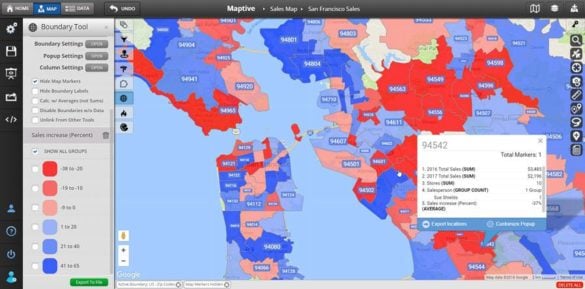
Your business wants to grow by adding new and profitable customers. Your team wants to earn by identifying and closing attractive prospects.
It’s a simple, mutually beneficial relationship. But there’s a third party that disproportionately impacts a sales team’s success or failure. That third party is sales territories.
And it’s not easy to create and optimize them, making it hard to generate the consistent sales growth your business needs.
Many companies use a territory plan template to help them move into new areas and scale their reach. Technology plays an important role in the process.
To help you create effective sales territory plan templates, we will explore foundational information, best practices, and approaches you need to build a successful territory planning.
Table of Contents
Before we jump into the different templates, what factors help create a successful sales territory plan? There are three simple things that you need to consider before starting the sales territory plan process:
These are your ultimate goals when working on sales territory plan templates: using the right data to create equity and balance. And a 30-60-90 plan is one of the best approaches to reaching those goals.
Like all sales territory plan templates, a 30-60-90 day sales territory plan serves as a framework. It’s a blueprint for building out a highly profitable territory for the business. A 30-60-90 day sales territory plan covers the following three things:
This is just a high-level overview of what it’s like to use a 30-60-90 day sales territory plan template. But you’ll want to consider your sales reps and your unique circumstances and needs when creating this type of plan for your business and sales team.
How do you create a 30-60-90 day sales strategy for your target market? To use this approach to creating a sales territory plan, follow these steps to develop strategies that help build your sales pipeline:
And then, it’s time to carry on into the future, continually optimizing and making adjustments as circumstances change. While there’s no end to the tweaks you’ll need to make to your sales territory plan, the 30-60-90 day approach accelerates your work and helps you build a viable territory as quickly as possible.
The 30-60-90 day approach to sales territory planning isn’t the only one available to you. You have other options you can use for your sales plan, which we explore below.
The simplest template for territory planning is looking at the biggest potential. This can include finding large metropolitan areas where prospects will be close in proximity. These areas are full of opportunity, and they allow your salespeople to maximize that opportunity by spending less time traveling and more time selling.
As an existing business, you likely have reams of data that can be used to create a territory plan template. Get geolocation data indicating where your existing customers are, where your latest opportunities are, and where your accounts sit in the pipeline.
The drawback to this approach is the echo-chamber effect. You’re working from your existing data, so there’s no opportunity to bring in third-party learnings that can positively impact your business.
Industry data can help you overcome the echo-chamber effect. Industry data that could be helpful include incorporation filings in various states, permit filings in various cities, as well as new developments in markets of interest.
The drawback to this approach is that it gives you information on areas that you’re already interested in. It cannot help you identify areas that you should be interested in.
There’s no shortage of data available to you. If you have time to get complex with your territory planning, you can combine your internal data and industry data with other information like census results, economic factors, consumer trends, etc.
This level of data can be incredibly insightful when planning territories, but it can also be unwieldy. You need a great deal of time and resources to properly use this approach to territory planning.
To properly use territory plan templates, you need technology that accelerates processes and gives you accurate data to make decisions.
At Maptive, we offer a platform that allows you to plan territories that are fully aligned with your sales goals. Our software offers a suite of tools that lets you take a data-driven approach to planning. Use Maptive in your sales process to:
We’ll soon introduce a feature that allows you to automate territory creation and optimization.
Maximize your territory planning and gain more market share when you start a free Maptive trial.
Brad Crisp is the CEO at Maptive.com, based in Denver, CO and born in San Francisco, CA. He has extensive experience in Business Mapping, GIS, Data Visualization, Mapping Data Analytics and all forms of software development. His career includes Software Development and Venture Capital dating back to 1998 at businesses like Maptive, GlobalMojo (now Giving Assistant), KPG Ventures, Loopnet, NextCard, and Banking.
